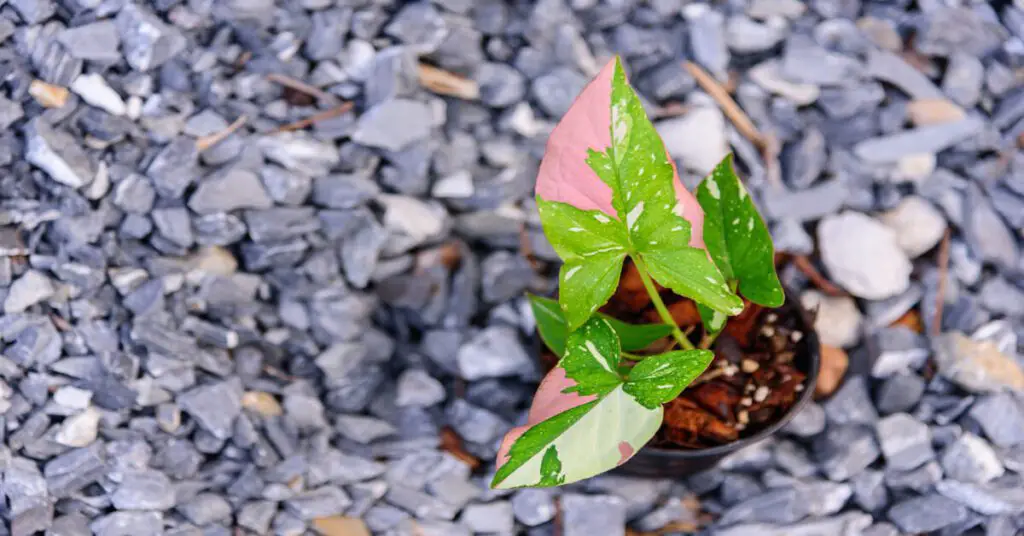If you’re asking yourself, what is a Syngonium red spot tricolor, don’t worry – we’re here to help! Syngonium red spot tricolor is a houseplant from the Araceae family and is part of the Syngonium genus. Its scientific name is Syngonium podophyllum, and it’s a Perennial type of plant that originates from South America, Mexico, and Bolivia.
Defining characteristics of the red spot tricolor plant are variegated red/pink, green, and white foliage with green stems. When grown against a wall or backing, it can reach 16ft tall or 5m. You can also find this plant listed under the names of tricolor red spot, arrowhead plant, and red spot tricolor Syngonium.
Syngonium Red Spot Tricolor Care
The great thing about arrowhead plant care is that it is easy. And with the proper knowledge, you can ensure your plant thrives.
From soil types to lighting needs and everything in between, you will find the information you need about the plant’s care below.
Soil
Like many houseplants, tricolor red spots enjoy well-draining soil. The addition of peat moss is advisable for this plant. You will want to place the plant in a pot with adequate drain holes to ensure the soil drains properly. It is also important to note that the soil pH should be between 5.5 and 6.0.
Watering
Keeping a mesic amount of moisture in the soil is optimal for the arrowhead plant. The best way to avoid over or under-watering the plant is by letting the top 2in of soil dry.
Lighting
Avoiding direct sunlight is best for the Syngonium tricolor. It thrives most when placed in bright but indirect lighting, although it can survive in a low-light environment.
Humidity & Temperature
Since the plant flourishes and is even becoming invasive in tropical rainforests, it prefers similar conditions[1]. Warmer temperatures between 65°F and 80°F or 18.3°C and 26.57°C are most suitable. It is also critical to maintain a high humidity level; you can do this by misting the plant frequently.
Fertilizing
If you need to fertilize your tricolor red spot Syngonium, use a mild liquid fertilizer for indoor plants. Additionally, when using fertilizer, apply it once a month when the plant is actively growing and discontinue use once winter arrives.
Propagation
To propagate this Syngonium, take cuttings and root them in either soil or water. When rooting in water, submerge the cutting’s node and change the water once a week. Once your roots form in the water, you can transfer them to a planter with a well-draining soil mixture.
Diseases & Pests
Known diseases for Syngonium plants, including tricolor red spots, are bacterial blight, stem rot, mesothelium leaf spot, and phosphorus deficiency.
If you notice a foul odor or dark green spots engulfing the leaves, your plant may have bacterial blight or stem rot. When that happens, you will need to discard the plant[2].
Myrothecium Leaf Spot causes fungal fruiting structures and browning leaves. If your plant has Myrothecium Leaf Spot, you need to apply a fungicide and avoid excessive use of nitrogen fertilizers.
With phosphorus deficiency, you may notice your plant has more dead spots amongst the lower leaves. If this occurs, use a balanced fertilizer.
Additionally, the plant is susceptible to common pests such as spider mites, aphids, scales, and mealybugs. These bugs can affect growth and overall plant health. That is because they remove sap or damage the cells. Use an appropriate insecticide if you notice these pests on your tricolor red spot.
Toxicity
This plant can be toxic if consumed. It contains calcium oxalate crystals, which cause drooling, vomiting, and swelling, especially when consumed by cats and dogs.
Syngonium Red Spot Tricolor vs Pink Splash
Pink splash is not the same as Syngonium red spot tricolor. Novice plant collectors often conflate the two because pink splash can also fall under the red spot. The difference between the two plants is that the tricolor variety tends to be more variegated by having bits of white strewn throughout the green and pink coloring.
References:
[1]Sandoval, J. R., & Rodríguez, P. A. (2013, December 7). Syngonium podophyllum (arrowhead vine). CABI. Retrieved October 7, 2022
[2]Moorman, G. W. (2016, July 31). Syngonium Diseases. PennState Extension. Retrieved October 8, 2022
[3]Tanbouly, R. E., Hassan, Z., & Messeiry , S. E. (2021, June 30). The Role of Indoor Plants in air Purification and Human Health in the Context of COVID-19 Pandemic. NIH National Library of Medicine. Retrieved October 8, 2022

